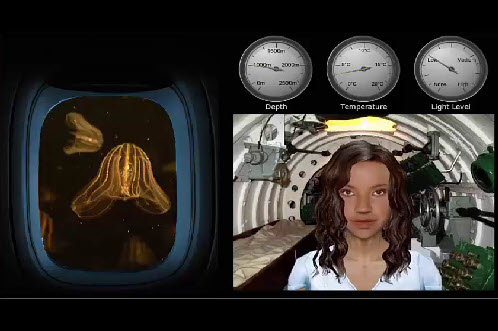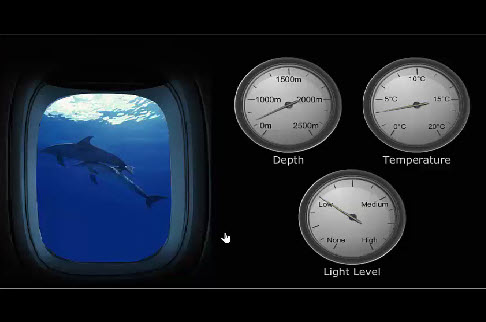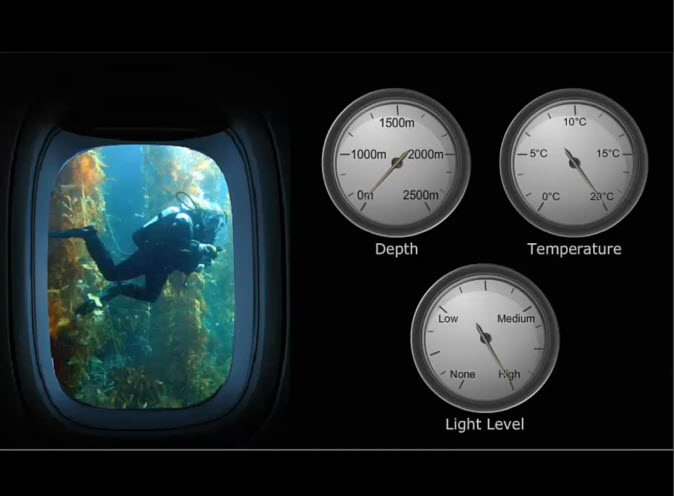 Avatar: Ascend Through the Pelagic Zones, Part I
Avatar: Ascend Through the Pelagic Zones, Part I
It’s time to begin the journey back to the surface. As Alvin is readied for the trip, Tamara reminds you that water that lies above the benthic zones, or zones along the ocean floor, is called the pelagic zone. It is similarly divided into subzones, which you’ll explore as you ascend.
Click the image below.
- apes_venusflytrap_386x580
Venus flytraps are limited by the moisture content of soil, pH of soil, and availability of nutrients in which to live.
- apes_hummingbird_580x387
Hummingbirds are limited by food resources, nesting habitats and environmental temperatures.
- apes_crocodile__580x387
Crocodiles are limited by food availability, habitat loss, water temperature and salinity, and high juvenile mortality.
- apes_treefrog_580x387
Frogs are often limited by proximity to water, high predation rates, high wintering mortality rate, and susceptibility to pollutants.
- apes_mushroom_580x387
Mushrooms are limited by moisture and soil conditions.
- apes_bacteria_580x488
Bacteria are found in almost all environments, including highly acidic hot springs and nuclear waste. However, they must have a food source in order to break down the nutrients to live.
- apes_paramecium_580x570
Paramecium are limited by the availability of food such as bacteria, algae and yeasts, and by the salinity level of the water.
- apes_human_387x580
Humans can adapt to many environmental changes, but are limited by food, water and shelter.
Text Version
In contrast to the organisms of the benthic zone, which tend to be constrained to the ocean floor, organisms in the pelagic zone move more freely and widely. They are classified as plankton (Greek for 'drifting') and nekton (Greek for 'swimming').
The vampire squid, basket stars, and sea spiders were visible through the port hole. In addition, swimming cucumbers are also found deep in the ocean. These organisms are adapted to live with no light, high pressure, cold temperatures and few nutrients.
Avatar: Ascending through the Pelagic Zones, Part II
![]() Around 1500 m, Alvin enters the bathypelagic zone. Click on the image below to join Tamara as she describes the sights during their ascent.
Around 1500 m, Alvin enters the bathypelagic zone. Click on the image below to join Tamara as she describes the sights during their ascent.
Text Version
 Avatar: Ascending through the Pelagic Zones, Part III
Avatar: Ascending through the Pelagic Zones, Part III
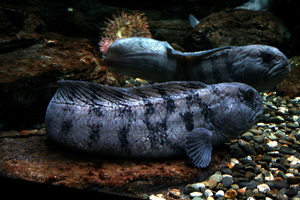 In the mesopelagic zone, you begin to notice a faint blue glow. You’re in the dysphotic (or twilight) zone, where there is just a hint of light. Without light there is no plankton and thus not enough food to support larger organisms. Free-swimming, or nektonic organisms in this region tend to be smaller and darker, with big mouths and long, sharp teeth. They have bigger eyes to maximize the amount of light and larger gills to cope with the decreased levels of dissolved oxygen. From the porthole, Tamara spots excellent examples of wolffish, swordfish, and squid.
In the mesopelagic zone, you begin to notice a faint blue glow. You’re in the dysphotic (or twilight) zone, where there is just a hint of light. Without light there is no plankton and thus not enough food to support larger organisms. Free-swimming, or nektonic organisms in this region tend to be smaller and darker, with big mouths and long, sharp teeth. They have bigger eyes to maximize the amount of light and larger gills to cope with the decreased levels of dissolved oxygen. From the porthole, Tamara spots excellent examples of wolffish, swordfish, and squid.
After ascending through the mesopelagic zone, the Alvin now reaches the epipelagic zone. Click below to join Tamara once again. (source: http://commons.wikimedia.org/wiki/File: Anarhichas_lupus_060417w.jpg)
Text Version
 Avatar: Ascending through the Pelagic Zones, Part IV
Avatar: Ascending through the Pelagic Zones, Part IV
Rising to the surface, the porthole is flooded with light and everyone breathes a sigh of relief to have returned safely. Now, Tamara must steer Alvin through the surface waters back to shore. At the surface, the pelagic zone is broken up into the neritic zone, which lies above the continental shelf, and the oceanic zone (also calledthe open ocean), which encompasses water beginning at the continental rise. Click below to join Tamara for the journey through the neritic zone. For more information about the layers of the ocean, visit the National Weather Service and NOAA’s website.
Text Version
 Avatar: Ascending through the Pelagic Zones, Part V
Avatar: Ascending through the Pelagic Zones, Part V
 Alvin makes its way back to shore through a coral reef ecosystem in the neritic zone. Join Tamara for the last bit of your journey. Welcome to one of my favorite places, the coral reef.
Alvin makes its way back to shore through a coral reef ecosystem in the neritic zone. Join Tamara for the last bit of your journey. Welcome to one of my favorite places, the coral reef.
Coral reefs are located in the warm, shallow waters of tropical areas. They are formed by the accumulation of calcium carbonate made by organisms called polyps. The reef forms as the polyps and other organisms excrete calcium carbonate to form exoskeletons, the exterior supportive structure for these organisms. As the calcium carbonate builds up, it provides habitat for living corals and a wide variety of epifauna, infauna, and tropical fish.
Coral reefs support a diverse and highly productive ecosystem, evidence of which can be seen in the photo below. It’s a beautiful sight.
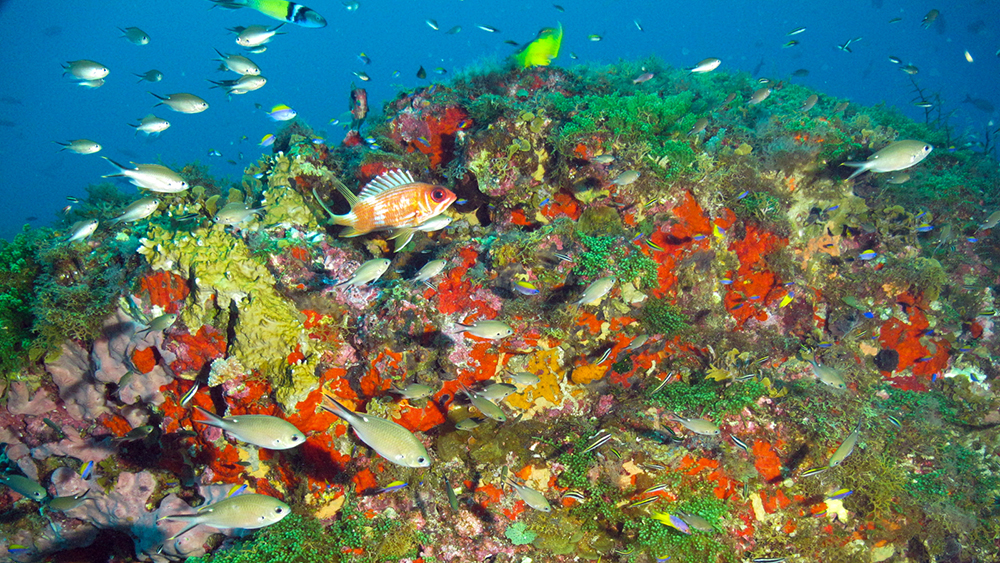
At a depth of 35 meters (115 feet), Bright Bank features an algal/sponge community typical of many shallower bank areas. Image courtesy of NOAA Flower Garden Banks National Marine Sanctuary/University of North Carolina Wilmington-Undersea Vehicles Program
Text Version
Pelagic Zones: Review
Now that you’re back to the world of landlubbers, we don’t want you to forget everything you learned during your time on Alvin. Use the quiz below to review key concepts about the pelagic zones.
Text Version


